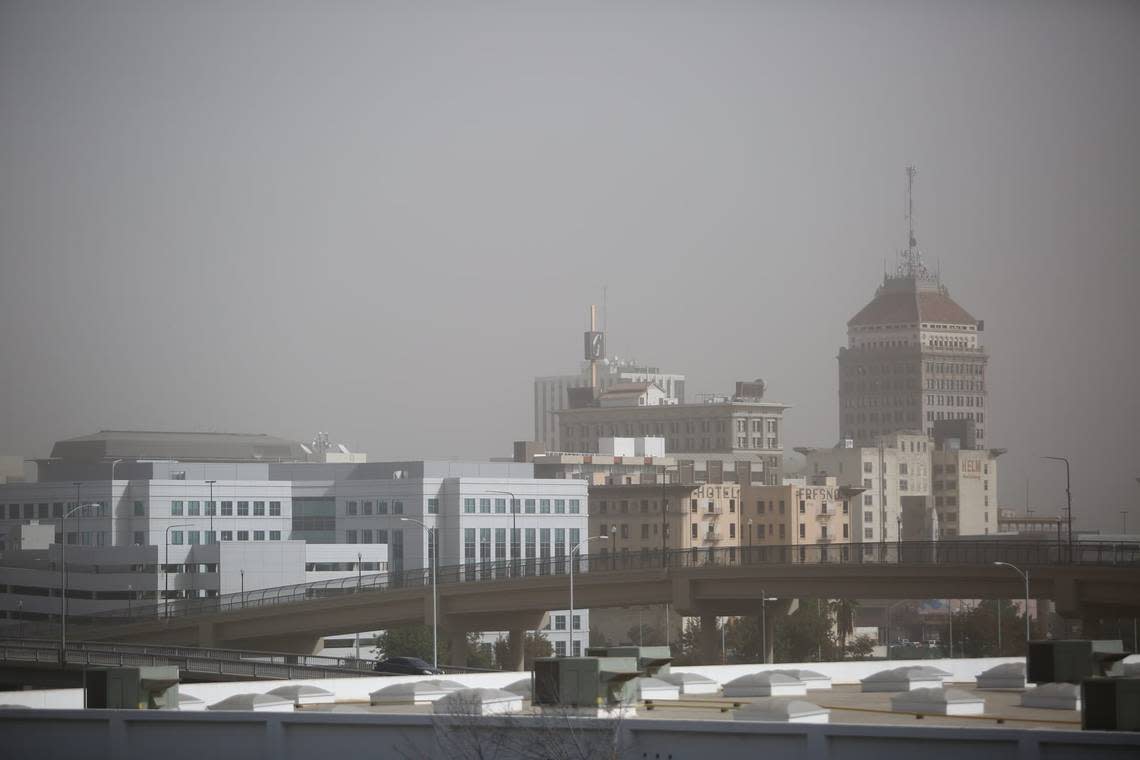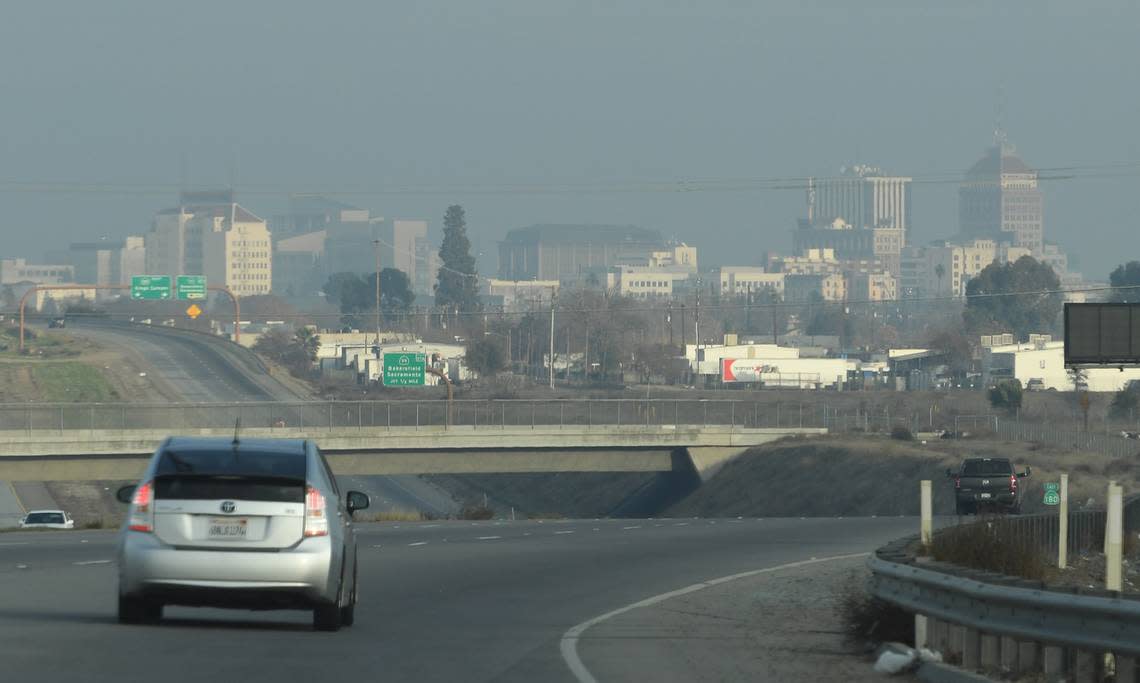Three resign in protest from San Joaquin Valley Air District group, calling it a ‘sham’
All three public members of a San Joaquin Valley air pollution advisory group have resigned, citing a lack of accountability for “systemic failures” in the group’s willingness to remediate past wrongdoing.
“It’s extremely distressing to know that the body tasked with protecting public health has been failing so dramatically in order to allow industry continued expansion,” said Sasan Saadat, a senior research and policy analyst with Earthjustice and one of the three public workgroup members that resigned in protest.
The San Joaquin Valley Air Pollution Control District’s Public Emission Reduction Credit Public Advisory Workgroup (PAW) was established in August 2020, in response to a 2020 California Air Resources Board report that identified “lack of transparency and substantial inconsistencies in the Air District’s Emission Reduction Credit Program,” according to a news release regarding the resignations.
Emission Reduction Credits are granted for voluntary emissions reductions when facilities control emissions to levels beyond current or future regulatory requirements, according to the Valley Air District website, and “and are only granted after a thorough review by the District has confirmed compliance with a number of (state and federal) criteria.”
However, the three public members — Catherine Garoupa White, executive director of Central Valley Air Quality Coalition a watchdog organization that advocates for clean air in the San Joaquin Valley, Jesus Alonso, a Kern oil and gas organizer with Clean Water Action, and Saadat — said the group isn’t doing enough to protect the public health of the residents that live in the most polluted air basin in the United States.
According to the San Joaquin Valley Air District website, the PAW’s guiding principles are to ensure “an effective permitting program that protects public health and supports economic growth and development in the Valley” and to provide “meaningful public engagement,” while ensuring the process “does not impede the District’s ability to meet legally mandated deadlines and timeliness.”
The workgroup meets monthly and is made up of three representatives from Valley community-based organizations, three representatives from Valley regulated entities, and three members from the Citizens Advisory Committee (one each from Environmental, Industry/Agriculture, City interest groups), as well as representatives from the federal Environmental Protection Agency and CARB.
But the resigning PAW members said they faced resistance when they made suggestions to the group, and business interests were consistently prioritized over public health.
Valley ERCs PAW Public Members_7.14.22 by Melissa Montalvo on Scribd
The “process was a sham,” Saadat in an interview with The Bee on Thursday. “Essentially, it was just committed to the appearance of public participation with no commitment to actual remedy.”
“The Public Advisory Workgroup is yet another disappointing failure by the San Joaquin Valley Air District that exposes their bias toward polluting industries,” said White in a news release announcing the decision. “They have failed to meaningfully incorporate advice from the public and community based organizations while seeking solutions to benefit industry.”
The Valley Air District responded to the news in email statement to The Bee on Thursday.
“We appreciate the members’ service on this important workgroup and look forward to continuing to work with them and other stakeholders on these and other important air quality issues,” said Jaime Holt, chief communications officer with Valley Air District.
“Through ongoing efforts in partnership with Valley stakeholders, the San Joaquin Valley Air District has adopted and enforced regulations that have achieved significant reductions in air pollution from local sources, reducing ozone and particulate-forming NOx emissions by over 90%, with new regulations recently adopted continuing to reduce emissions in the coming years.”
Valley Air District credit for emission reductions a ‘broken system?’
Saadat said there were a number of factors that went into the decision, but ultimately the trio decided to resign because their specific requests were “consistently declined.” One such request they made was for the air district to complete a thorough review of the CARB report’s findings about the need for more transparency in the emission credit reduction program.
Saadat said that CARB’s report didn’t give the full picture.
“It was just a sample,” he said, but it showed “widespread problems” over crediting projects that didn’t deserve credit, such oil well shutdowns that would have happened anyway, overvaluing credits or awarding credits where there was no documentation, double claiming credits for electrification projects that already received state funding, and more, said Saadat.
“We’ve asked for the Air District to complete the review because, again, CARB’s review was just sampling,” said Saadat. “We don’t know the full extent how much pollution was permitted.”

“The Air District’s refusal to address and quantify the inconsistencies and discrepancies identified in the CARB report and raised by PAW (Public Advisory Workgroup) members is evidence of an unwillingness to collaborate and an unwillingness to compensate our disadvantaged communities for the mismanaged credits,” said Alonso, the third public workgroup member to resign. “Essentially this broken system creates a double problem: first it allows credits for emission reductions that don’t actually happen and second, it robs communities of the opportunity to increase direct emission reductions.”
Saadat said that the advisory group was overly focused on making sure the process was more transparent going forward, but never addressed the public’s concern about remedy for past harm.
“One would hope that a public advisory group based on such a scandalous finding in this audit would be committed to repairing the harm done,” he said.
Valley Air District defends their track record
Holt, the spokesperson for the Valley Air District, said the “District Governing Board has taken a number of significant actions to enhance the District’s ERC program and address the recommendations in CARB’s review, the most significant of which dealt with the federally approved offset equivalency program for NOx and VOC (volatile organic compounds).” According to the EPA, VOCs are a type of pollutant often found in human-made chemicals that are used and produced in the manufacture of paints, pharmaceuticals, and refrigerants.
“As a result of these actions, the District is no longer operating a federal offset equivalency system for NOx and VOC, and all new major sources or federal major modifications are required to directly comply with offsetting requirements in the federal Clean Air Act.”
Holt said the District’s Board actions also include initiating a public process to amend Rule 2201, New Source Review, to formalize these changes and “ensure the applicability and offset requirements within Rule 2201 comply with the federal new source review requirements.”
However, Saadat said these actions don’t go far enough.
There are multiple pollutant “banks,” in addition to NOx and VOC. “They didn’t do a review of the other pollutant banks in the ERC system, only the NOx and VOC ones.”
Ultimately, Saadat insists that the district didn’t do enough to address former mismanagement of the ERC program.
“They’ve never reconciled the fact that pollution that should never have been permitted, was permitted, and therefore there is a deficit, a shortfall of emissions reductions that we now need to make up” he said.
Calls for more public engagement, state, federal regulators to step in
Despite their resignations, the three advisory members said they will “continue to scrutinize the process going forward,” said Saadat.
”We will continue to try and hold their district accountable to repair the damage that has been done as a result of its regulatory failure,” he said.
“CVAQ will continue to pursue reconciliation and justice, but I can no longer give cover to this performative process,” said White.
Saadat called for state and federal regulators to step in where there’s “clearly been a vacuum of leadership at the district level.”
He also called for more residents and community members to “raise their voice and call for accountability.”
“Residents have every reason to feel very concerned that the Air District —whose job is to protect public health —is more focused on ensuring that industry can continue and helping them navigate environmental regulations sometimes in ways that are extremely specious.”

